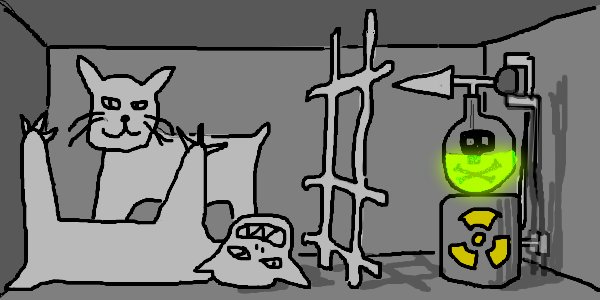
Schrödinger found superposition so odd that he illustrated its absurdity by a thought experiment. He imagined his cat in a box with a device that would release poison gas if it detected a photon of light, then added a radioactive source that randomly emitted photons. The box is closed, so no-one knows when the gas is released, but according to quantum theory, the source and device are a system that superposes a photon being detected and not, until it is observed. Hence that the poison is released and not also superposes, so the cat is in an alive-dead superposition until Schrödinger opens the box! But how can a cat be alive and dead? Or if cats can’t be alive and dead, how can a photon exist and not exist? Or if a photon can do this but a cat can’t, when does the superposition stop?
Schrödinger’s example argued that quantum micro-scale events make no sense at the macro-scale. The idea that Schrödinger’s cat can be both alive and dead is ludicrous, but doesn’t quantum theory imply it? It doesn’t because quantum theory doesn’t need human observation to stop a superposition, just an observation. It follows that if every physical event is an observation, his cat is never alive and dead. For Schrödinger’s cat, the photon superposition collapses when the detector observes it, so it releases the poison regardless of what Schrödinger observes. Before opening the box, Schrödinger doesn’t know if his cat is alive or dead, but the cat does, or did! Quantum superposition is stopped by any observation, not just ours, so there is no alive-dead cat.
A processing model supports quantum theory, as any network overload that causes a physical event collapses the quantum wave along with any superpositions. This implies that every physical event is an observation by something. It seems strange to say that everything observes, but the logic of quantum theory is, as usual, impeccable. If only humans could observe, then according to quantum theory, we would be needed to cause physical events, which can’t be. If it were so, the initial universe superposition couldn’t collapse until we evolved, but it did. That we are necessary for physical history to begin isn’t sensible. The alternative is that everything observes, not just our eyes or instruments, so quantum waves have been collapsing into physical events since the beginning of time.
This approach also clarifies the concern that quantum theory implies that observation creates events, as in a dream, which contradicts realism. If observation formally causes physical events, as quantum theory says, is our world a dream? If every physical event is a mutual observation, as it seems to be, then we aren’t the only ones causing physical events. In a dream, the observer alone causes the dream but our world isn’t only caused by us, so it isn’t a dream. We aren’t creating the universe alone, everything is, so the photon we observe is also observing us. That every observation creates a physical event implies a virtual world, but not a dream world.
Schrödinger’s alive-dead cat, intended to illustrate the absurdity of quantum theory, instead shows its depth. Machines that follow fixed laws don’t evolve, so your computer’s motherboard doesn’t update itself, but a child’s brain does. Natural selection requires the ability to select, and quantum uncertainty ensures there is always choice, so our universe was able to evolve, as it did.